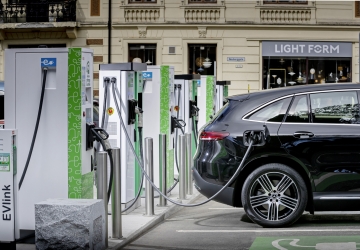What does COVID-19 teach us about the future of e-mobility?

Covid-19 has most of us confined to our homes, with a significant impact on our economy. Like in any other crisis, this has an immediate impact on our electricity consumption. E-mobility is strongly related to the availability and pricing of our energy. So let’s start there.
Covid-19 has most of us confined to our homes, with a significant impact on our economy. Like in any other crisis, this has an immediate impact on our electricity consumption. E-mobility is strongly related to the availability and pricing of our energy. So let’s start there.
Sneak peek into the future: more active usage of zero carbon energy when available
But this might be a sneak peek into our energy system future, as today, renewables in Europe are mounting up to 15-20% of the generation, yet are set to increase significantly the coming decades. Even if our demand post Covid-19 mounts up again, we’ll have significant more periods where we need active consumers to switch on when zero-carbon, cheap energy is abundantly available, or prices will go below zero regularly.
Enter new business opportunities
Yet we don’t consume energy for the fun of it. We need a useful purpose for it at the same moment that it is produced, or we need to store it. The electrical grid is experiencing many challenges today, partially caused by an increase in renewables and an increased electrification of the society. Managing the balance between demand and supply is therefore becoming more challenging every day to keep the grid stable.
Hence electric batteries and thermal storage are making an entry at an accelerated rate driven by this opportunity, while their cost drops significantly. So are batteries on wheels, with ever increasing storage capacity to provide more range for the same money to every new electric car model that gets introduced. This increasing storage capacity in electric vehicles might just be, at least partially, the answer in our zero-carbon, renewable driven energy system in the future. An average EV today packs a whopping 80 kWh of electricity, meaning roughly 400km range. While we on average drive only 10% of that range on a daily basis, and the car would be able to charge overnight. But it could just as well charge when there is this abundancy of energy available, as sun or wind will be nearly always available if you have about 10 days to wait for them.
Will we choose as green as possible over as soon as possible in mobility?
But imagine how this will change the way we look at transport in general. Our ‘just in time’ mantra which obliges transport to act ‘as quickly as possible’, might just get challenged by a ‘as green as possible’ option. Another thing Covid-19 teaches us, is the resilience of the online shopping industry to crisis moments like these. ‘Order today, get it tomorrow’ might become 1 of the options, next to ‘get it delivered green & cheap’. In the latter option, the electric delivery vans will remain parked until they got charged with abundant sun & wind generation. A couple of days delay versus a cheaper, carbon-free delivery. What option will you choose?
Nearly 1000 electric buses will join De Lijn bus fleet over the next 15 years. As they are usually parked during the night, bus depots are getting equipped with significant upgrades of their electrical installation. As such, buses can contribute to the electrical grid stability.
Let’s expand our dream with new future technologies such as vehicle-to-grid. In a nutshell: your car can discharge its’ battery back into the grid when necessary. 80 kWh of flexibility. Or roughly 9 days of an average household electricity consumption. Charge it during that sunny day, or that windy storm, and run on it for a week since your car is able to provide this stock. Or have that online shop deliver your order to you at an even lower cost, as the delivery vans help the system when sun & wind are absent for a couple hours/days, and gain a profit from your time flexibility. Accurate production forecasting of weather conditions might even provide you with a clear view on when your car is best plugged in. As such, transport might move from a CO2 emitting sector to a solution that helps us phase out fossil fuel generation by 2030.
Special thanks to Dieter Jong, energy expert at Eiya Consult and Steven Van Deun, Segment Lead Smart Cities Benelux at ABB.
Latest insights & stories

A Global Movement: The World Unites in a Pink Pledge for Clean and Sustainable Water
5,000 participants. 32 countries. €30,000 funds raised. And that's just the beginning.
Picture this: One step that sends ripples across the globe, transforming lives and creating waves of change. You might wonder, how can such a simple action for most of us have such a profound impact?

Sustainability and circularity in construction
Join us in transforming the future of construction, creating buildings that not only stand the test of time but also contribute to a healthier planet!

RainTunes: Shower scenarios for the soul
Light, hearing, smell, and touch: Together with experts, we have developed sensuous scenarios that turn showering into an individual experience. Whether you want to prepare for the day ahead or relax after working out. Whether you want to refresh after a day’s work or unwind at the end of the evening: RainTunes surprises with multisensory experiences.*
*Currently available only in Germany and Austria.